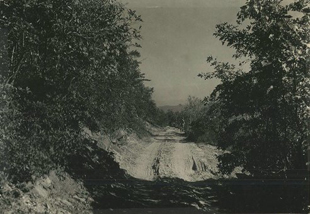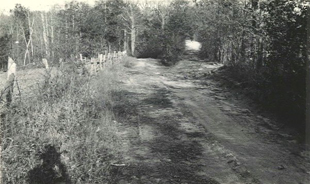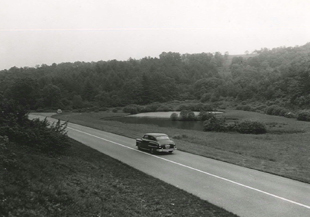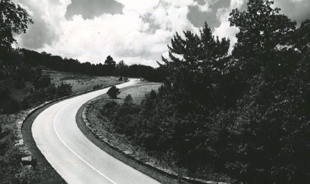
'We Drivers': Alleghany County's New Relationship with the Automobile
By Michael Penny

1930 Road Survey of Alleghany County
North Carolina State Highway Commission
North Carolina Maps Digital Collection,
University of North Carolina at Chapel Hill
The Blue Ridge Parkway was conceived during a period of expanding automobile use, widespread road construction, and a cultural fascination with the automobile. Nestled in the Blue Ridge Mountains in northwest North Carolina, Alleghany County contains the first Parkway section built in the state (section "2A"), with construction spanning from 1935 to 1939. A look at the Alleghany Times during this period provides an interesting view into the way the region was negotiating its relationship with cars, roads, and the prospect of a new scenic highway.
The paper focused some attention on drivers themselves. It featured guides to driving safety, syndicated columns written by General Motors that were printed in newspapers throughout the country. The simplicity of these guides--which gave advice about such things as braking in slippery conditions--might reflect the editors' perception that locals lacked practical driving skills. At the same time, editorials lamented the deadly results of citizens "unable to resist the temptation to step on it," combined with a new automobile culture that "placed a dangerous plaything in the hands of drivers."

Typical Country Road in Western North Carolina, 1936
Photograph by A. S. Burns
Courtesy National Park Service, Blue Ridge Parkway
As driving safety became a contentious issue in Alleghany, the region's primitive road conditions were also targets of criticism. Alleghany County road survey maps from 1930 and 1936 show fewer than 100 miles of paved roads in the county, with the vast majority of roads yet “unimproved.” These conditions were similar to those throughout the South in the early 20th century.
Efforts to improve roads in the South were successful due in part to the advocacy of the various “good roads” associations who lobbied intensely for their improvement. Formed before the turn of the century, the good roads associations gained in size and influence with the proliferation of the automobile. Chiefly composed of business leaders, civil servants, engineers, and auto enthusiasts, these groups lobbied for improved, auto-friendly roads. One such group was the Southern Appalachian Good Roads Association, formed in 1909, which focused on creating a network of mountain roads that would help facilitate tourism in the region.[1] This advocacy coincided with the Federal Aid Road Act of 1916 (expanded under the 1921 Federal Aid Highway Act), which provided funding to states to help with road construction.[2]

Unmaintained county road in Alleghany County, 1936
North Carolina State Highway Commission
North Carolina Maps Digital Collection,
UNC Chapel Hill
The Alleghany Times prominently reported on a national auto industry coalition's campaign to improve both driving safety and road conditions. Members of the coalition--including auto manufacturers, insurers, and government organizations--pledged to build "highways of the highest quality" that were "best adjusted to the safe use of the modern vehicle." For residents of a county with only a handful of paved roads, such promises must have seemed especially tantalizing. In the late 1920s Alleghany slowly began to see results from the drive to improve roads, with paved roads replacing ungraded, poorly maintained wagon trails. [3]
While road quality received considerable attention, many people had grand visions for the future of the wider national road system. Alleghany County seemed to be at the crossroads of two of these projects. The Lakes-to-Florida highway was intended to provide a direct overland route for travel from the Midwest to Florida. This route's last miles to be improved were in Alleghany, and its completion was to afford "tourists a straight, surfaced highway all the way to Florida." That a paved surface was, in itself, an attractive feature gives some indication of the road standards of the time.
President Franklin Roosevelt had grand ideas for similar major road routes, including a scenic, tourist-friendly parkway that would stretch from Maine to the Gulf of Mexico. These road construction plans were not only a product of the newly emerging American culture in which the automobile played an increasingly large role; they were also public works projects that were viewed as an integral part of economic recovery during the Depression. The construction of the Parkway was a boon to the Alleghany's suffering economy. The Times reported that the first sections of the Parkway built employed over 1,400 men, 350 of whom lived in Alleghany.
The Blue Ridge Parkway was not just a scenic road for tourists; like many public works project of the time, it was deeply rooted in the rhetoric of progress. Advocates for the Parkway extolled a blend of both progressivism and reverence for the natural and the scenic. Editorials in the Times proclaimed the symbolic value of the Parkway as “one grand step, side by side with man’s progress” in conquering nature. “Man has secured and chained to his service the elemental forces of nature,” the paper claimed, and the Parkway was a further step in “the progress of civilization.”
1. McKown, Harry Wilson, Jr. Roads and Reform: The Good Roads Movement in North Carolina, 1885–1921. Master’s thesis, University of North Carolina, 1972.
2. Kaszynski, William. The American Highway: The History and Culture of Roads in the United States. Jefferson, N.C.: McFarland, c2000.
3. "Parkway Is Big Boon" Winston-Salem Journal, August 2nd 1959; North Carolina Collection Clippings File, Reel 1 Volume 3 Number 882.





